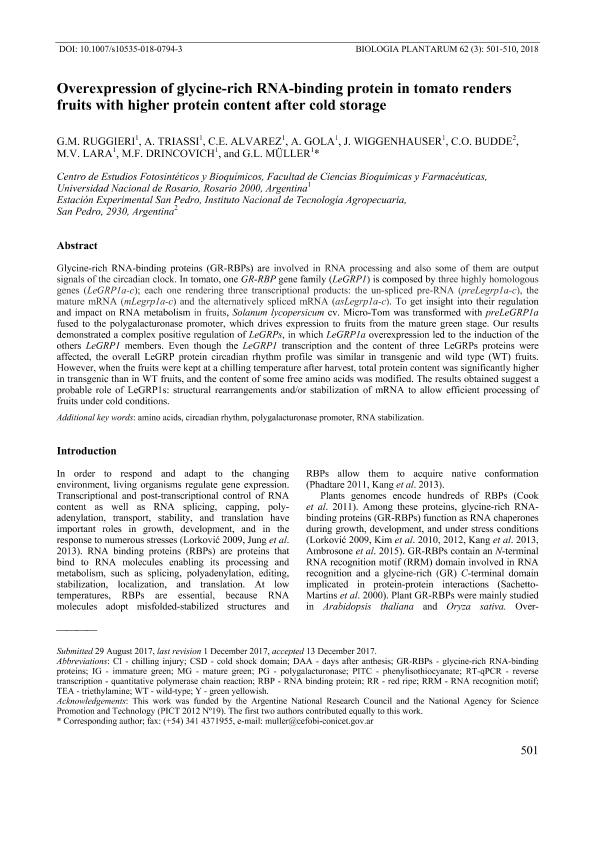Artículo
Overexpression of glycine-rich RNA-binding protein in tomato renders fruits with higher protein content after cold storage
Ruggieri, Germán Miguel; Triassi, Agustina ; Alvarez, Clarisa Ester
; Alvarez, Clarisa Ester ; Gola, A.; Wiggenhauser, J.; Budde, Claudio Olaf; Lara, Maria Valeria
; Gola, A.; Wiggenhauser, J.; Budde, Claudio Olaf; Lara, Maria Valeria ; Drincovich, Maria Fabiana
; Drincovich, Maria Fabiana ; Müller, Gabriela Leticia
; Müller, Gabriela Leticia
 ; Alvarez, Clarisa Ester
; Alvarez, Clarisa Ester ; Gola, A.; Wiggenhauser, J.; Budde, Claudio Olaf; Lara, Maria Valeria
; Gola, A.; Wiggenhauser, J.; Budde, Claudio Olaf; Lara, Maria Valeria ; Drincovich, Maria Fabiana
; Drincovich, Maria Fabiana ; Müller, Gabriela Leticia
; Müller, Gabriela Leticia
Fecha de publicación:
09/2018
Editorial:
Springer
Revista:
Biologia Plantarum
ISSN:
0006-3134
e-ISSN:
1573-8264
Idioma:
Inglés
Tipo de recurso:
Artículo publicado
Clasificación temática:
Resumen
Glycine-rich RNA-binding proteins (GR-RBPs) are involved in RNA processing and also some of them are output signals of the circadian clock. In tomato, one GR-RBP gene family (LeGRP1) is composed by three highly homologous genes (LeGRP1a-c); each one rendering three transcriptional products: the un-spliced pre-RNA (preLegrp1a-c), the mature mRNA (mLegrp1a-c) and the alternatively spliced mRNA (asLegrp1a-c). To get insight into their regulation and impact on RNA metabolism in fruits, Solanum lycopersicum cv. Micro-Tom was transformed with preLeGRP1a fused to the polygalacturonase promoter, which drives expression to fruits from the mature green stage. Our results demonstrated a complex positive regulation of LeGRPs, in which LeGRP1a overexpression led to the induction of the others LeGRP1 members. Even though the LeGRP1 transcription and the content of three LeGRPs proteins were affected, the overall LeGRP protein circadian rhythm profile was similar in transgenic and wild type (WT) fruits. However, when the fruits were kept at a chilling temperature after harvest, total protein content was significantly higher in transgenic than in WT fruits, and the content of some free amino acids was modified. The results obtained suggest a probable role of LeGRP1s: structural rearrangements and/or stabilization of mRNA to allow efficient processing of fruits under cold conditions.
Palabras clave:
AMINO ACIDS
,
CIRCADIAN RHYTHM
,
POLYGALACTURONASE PROMOTER
,
RNA STABILIZATION
Archivos asociados
Licencia
Identificadores
Colecciones
Articulos(CEFOBI)
Articulos de CENTRO DE EST.FOTOSINTETICOS Y BIOQUIMICOS (I)
Articulos de CENTRO DE EST.FOTOSINTETICOS Y BIOQUIMICOS (I)
Citación
Ruggieri, Germán Miguel; Triassi, Agustina; Alvarez, Clarisa Ester; Gola, A.; Wiggenhauser, J.; et al.; Overexpression of glycine-rich RNA-binding protein in tomato renders fruits with higher protein content after cold storage; Springer; Biologia Plantarum; 62; 3; 9-2018; 501-510
Compartir
Altmétricas



